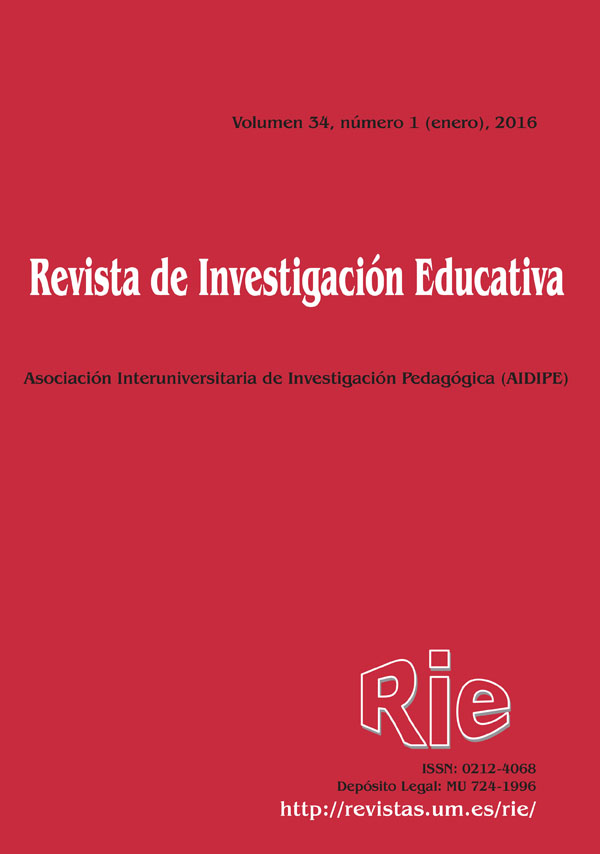Fearand academic achievementin the pluricultural context of Ceuta
Abstract
The main objective of this paper is to reflect the types and levels of Fear and Academic Achievement (and the influence over each other), of students in the city of Ceuta. To make it possible we focused on 1186 participants from 9 different educational institutions that clearly reflect the city’s pluricultural features; 42.2% of them are boys and 57.8% girls; 58.9% of the total are Muslims and 41.1% Christians. The techniques used in this survey are FSSC-II, adapted by Ascensio, Vila, Robles-García, Páez, Fresán & Vázquez (2012), the Matesanz (2006) adaptation of FSS as well as the children›s grades. The results show medium levels on Fear and Achievement, and they are influenced by the sociodemographic factors of age, gender, customs/religion and socioeconomic and cultural. We have also found a relationship between Fear and Academic Achievement. Evolutive development and different nurturing patters justify these differences. There is an inverse ratio between Fear and Achievement that is why emotion training and development may be a key element to personal and professional success.
Downloads
References
Alonso, J. & Román, J. M. (2014). Nivel sociocultural, prácticas educativas familiares y autoestima de los hijos en edades tempranas. Revista de Investigación Educativa, 32(1), 187-202.
Ascensio, M., Vila, M. G., Robles-García, R., Páez, F., Fresán, A. & Vázquez, L. (2012). Estudio de traducción, adaptación y evaluación psicométrica del Inventario de Miedos FSSC-II en una muestra de estudiantes de educación media superior. Salud Mental, 35, 195-203.
Burnham, J. J. (2007). Children’s fears: A pre-9/11 and post −9/11 comparison using the American Fear Survey Schedule for Children (FSSC-AM). Journal of Counselling and Development, 85, 461–466. http://dx.doi.org/10.1002/j.1556-6678.2007.tb00614.x
Burnham, J., Hooper, L. & Ogorchock, H. (2011). Differences in the Fears of Elementary School Children in North and South America: A Cross-Cultural Comparison. International Journal for the Advancement of Counselling, 33, 235–251. http://link.springer.com/article/10.1007%2Fs10447-011-9131-7
Burnham, J. J. & Lomax, R. (2009). Examining ethnicity and fears of children and adolescents in the United States: differences between White, African American, and Hispanic populations. Journal of Counselling and Development, 87, 387–393. http://dx.doi.org/10.1002/j.1556-6678.2009.tb00122.x
Ford, B., Mauss, I., Troy, A., Smolen, A. & Hankin, B. (2014). Emotion Regulation Moderates the Risk Associated With the 5-HTT Gene and Stress in Children. Emotion, 14(5), 930–939. http://dx.doi.org/10.1037/a0036835
García-García, M., Biencinto-López, C., Carpintero-Molina, E., Núñez-del-Río, M. C. & Arteaga-Martínez, B. (2013). Rendimiento en Matemáticas y actitud hacia la materia en centros inclusivos: estudio en la Comunidad de Madrid. Revista de Investigación Educativa, 31(1), 117-132.
Goleman, D. (1996). Inteligencia Emocional. Barcelona: Kairós.
Gómez-Castro, J. L. (1986). Rendimiento escolar y valores interpersonales: Análisis de resultados en E.G.B. con el cuestionario SIV de Leonardo V. Gordon. Bordón, 262, 257-275.
Hernández, E., Rodríguez, F. J. & Moral, M. V. (2011). Adaptación escolar de la etnia gitana: relevancia de las variables psicosociales determinantes. Apuntes de Psicología, 29(1), 87-105.
Kushnir, J., Gothelf, D. & Sadeh, A. (2014). Nighttime fears of preschool children: A potential disposition marker for anxiety? Comprehensive Psychiatry, 55, 336–341. http://dx.doi.org/10.1016/j.comppsych.2013.08.019
Lane, B. & Gullone, E. (1999). Common fears: A comparison of adolescents’ self-generated and fear survey schedule generated fears. The Journal of Genetic Psychology, 160(2), 194-204.
Martínez, M. & Alfageme, A. (2004). Integración socioeducativa del alumno gitano en la escuela española. Revista española de educación comparada, 10, 299-324.
Matesanz, A. (2006). Datos para la adaptación castellana de la Escala de Temores (FSS). Análisis y Modificación de Conducta, 32(144), 521-551.
Méndez, F.X., C.J., Hidalgo, M.D., García-Fernández, J.M. & Quiles, M.J. (2003). Los miedos en la infancia y la adolescencia: un estudio descriptivo. Revista Electrónica de Motivación y Emoción, 6(13), 23-31. http://reme.uji.es/articulos/amxndf4650710102/texto.html
Miloyan, B., Bulley, A., Pachana, N. & Byrne, G. (2014). Social Phobia symptoms across the adult lifespan. Journal of Affective Disorders, 168, 86-90.
Roa, J. M. (2006). Rendimiento escolar y “situación diglósica” en una muestra de escolares de educación primaria en Ceuta. Revista Electrónica de Investigación Educativa, 8(1), 1-15. http://redie.uabc.mx/vol8no1/contenido-roa.html
Roth, G., Benita, M., Amrani, C., Shachar, B., Asoulin, H., Moed, A., … Kanat-Maymon, Y. (2014). Integration of negative emotional experience versus suppression: Addressing the question of adaptive functioning. Emotion, 14(5), 908–919. http://dx.doi.org/10.1037/a0037051
SPSS Inc. Released 2011. IBM SPSS Statistics for Windows, Version 20.0. Armonk, NY: IBM Corp.
Sroufe, A. (2000). Desarrollo Emocional: La Organización de la Vida Emocional en los primeros años. México: Oxford University Press.
The articles and scientific documents published in RIE abide the following conditions:
1. The Servicio de Publicaciones de la Universidad de Murcia (the publisher) has the property rights (copyright) of all the documents published and allows the reuse under the user’s license indicated in point 2.
2. All documents are published in the digital edition of RIE under a Creative Commons Reconocimiento-NoComercial-SinObraDerivada 3.0 España (legal document) license. These documents can be copied, used, distributed, communicated and explained publicly if: i) the author(s) and its original source of publishing (magazine, publisher and URL of the document) are cited; ii) it is not used for commercial purpose; iii) the existence and the specifications about this license are mentioned.
3. Auto-archive’s conditions. The authors are allowed and encouraged to digitally distribute the pre-print versions (a version before evaluation) and/or post-print (a version that it is already evaluated and accepted to its publication). This promotes circulation and distribution earlier and can increase the citations and significance within the academic community.










